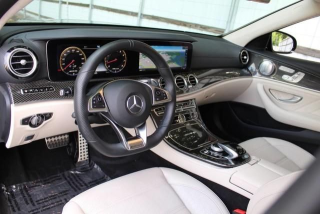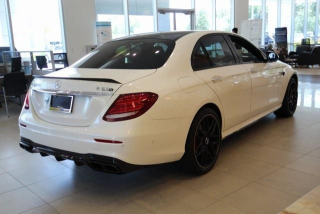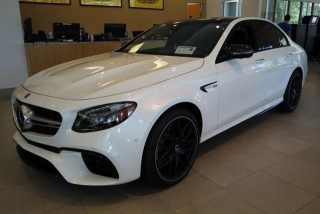The Good
The 2018 E-Class offers a superb blend of performance, from the efficient E300 to thrilling AMG variants, coupled with unrivaled cabin comfort and exquisite materials. Its elegant design appeals emotionally, while advanced safety systems and robust build quality satisfy practical buyers. The ride is exceptionally smooth, the technology is cutting-edge, and its overall refinement sets a high standard in the luxury segment.
The Bad
Potential buyers should watch out for the high cost of maintenance and repairs, common with luxury vehicles. The complex infotainment system can have a learning curve, and sophisticated electronics may occasionally exhibit glitches. While generally reliable, any issues can be expensive to address, and the base E300 engine might feel underwhelming for performance enthusiasts.
2018 Mercedes-Benz E-Class: Quick Overview
The 2018 Mercedes-Benz E-Class offers a robust range of specifications across its various trims:
- Engine Options & Horsepower:
- E300: 2.0L turbocharged 4-cylinder, 241 hp, 273 lb-ft torque.
- E400: 3.0L bi-turbo V6, 329 hp, 354 lb-ft torque.
- AMG E43: 3.0L bi-turbo V6, 396 hp, 384 lb-ft torque.
- AMG E63 S: 4.0L bi-turbo V8, 603 hp, 627 lb-ft torque.
- Fuel Economy (EPA Combined):
- E300 (RWD): ~25-26 MPG
- E300 (4MATIC): ~24-25 MPG
- E400 (4MATIC): ~22-24 MPG
- AMG E43 (4MATIC): ~20-21 MPG
- AMG E63 S (4MATIC): ~18-19 MPG
- 0-60 MPH Times:
- E300: ~6.2-6.3 seconds
- E400: ~5.1-5.2 seconds
- AMG E43: ~4.5 seconds
- AMG E63 S: ~3.3-3.4 seconds
- Towing Capacity: The E-Class sedan, coupe, and cabriolet are generally not rated for significant towing in the U.S. market. Specific E-Class Wagon variants in other markets might have a light towing capacity (e.g., 1,650-2,100 lbs), but for most U.S. models, Mercedes-Benz does not recommend towing.
- Trim-Level Features:
- E300: Equipped with a 12.3-inch infotainment display, COMAND interface, Apple CarPlay/Android Auto, MB-Tex upholstery, dual-zone automatic climate control, power front seats, LED headlights, rearview camera, and Active Brake Assist. Optional features include genuine leather, a Burmester surround sound system, and a panoramic sunroof.
- E400: Adds the more powerful V6 engine and often includes more premium amenities as standard, such as leather seating, a panoramic sunroof, and available AIR BODY CONTROL air suspension for enhanced ride comfort.
- AMG E43: Features the performance-tuned V6 engine, AMG-specific exterior styling elements, sport suspension tuning, upgraded brakes, and interior enhancements like sport seats and AMG instrumentation.
- AMG E63 S: The pinnacle of performance, boasting the V8 bi-turbo engine, AMG Performance 4MATIC+ all-wheel drive with Drift Mode, track-ready suspension and braking systems, aggressive aerodynamic bodywork, and a luxurious, performance-oriented interior with Nappa leather and carbon fiber trim.
- Common Optional Packages: The Premium Package added features like a Burmester sound system and heated front seats. The Driver Assistance Package included advanced technologies such as adaptive cruise control, lane-keeping assist, and steering assist, greatly enhancing safety and convenience.
2018 Mercedes-Benz E-Class Specifications
Vehicle Information
| Year | 2018 |
| Make | Mercedes-Benz |
| Model | E-Class |
| Trim | - |
| Style | - |
| Type | Sedan |
| Category | Compact Car |
Manufacturing Details
| Made In | Germany |
| Manufacturing City | SINDELFINGEN |
Dimensions
| Doors | 4-Door |
| Curb Weight | - |
| Gross Vehicle Weight Rating | - |
| Overall Height | - |
| Overall Length | - |
| Overall Width | - |
| Wheelbase Length | - |
| Standard Seating | 5 |
Engine & Performance
| Engine | M274 |
| Engine Size | 4L |
| Engine Cylinders | 8 |
| Transmission | 9 Automatic |
| Transmission Type | Automatic |
| Transmission Speeds | 9-Speed |
| Drivetrain | All-Wheel Drive |
Additional Features
| Anti-Brake System | Standard |
| Steering Type | - |
Pricing
| Manufacturer Suggested Retail Price (MSRP) | - |
| Invoice Price | - |
| Delivery Charges | - |
Vehicle History Report
Specifications
History
Events
History Check
Check
Check
Check
Check
Listings
Recalls
Check
Analysis
What Problems Does the 2018 Mercedes-Benz E-Class Have?
One common area involves the sophisticated COMAND infotainment system, with owners occasionally reporting software glitches, screen freezes, or connectivity problems. These are often resolved with software updates, but highlight the complexity of modern automotive electronics. Another concern for models equipped with AIR BODY CONTROL air suspension is the potential for leaks or compressor failures over time. While providing an exceptional ride, air suspension components are costly to repair or replace when they fail, typically after many years or higher mileage. Minor electrical gremlins, such as faulty sensors or illuminated warning lights, can also occur, though these are often sporadic. Some owners also note minor interior rattles or creaks.
Regarding recalls for the 2018 E-Class, several significant ones have been issued by NHTSA. These include recalls related to a potentially faulty fuel pump relay that could cause engine stalling (NHTSA Campaign Number: 19V018000), incorrect ESP control unit software affecting stability (18V643000), and issues with headlight adjustment (19V088000). Other recalls addressed potential problems with the passenger front airbag wiring harness (18V072000), power steering software causing a loss of assist (18V029000), and an improperly routed transmission wiring harness (18V026000). There were also recalls for rear seatbelt buckles and driver seat backrests. It is highly recommended to check the specific VIN of any prospective vehicle for all completed and outstanding recalls.
Long-term reliability is generally good for Mercedes-Benz, but the primary concern is the cost of ownership. As the vehicle ages and approaches or exceeds 100,000 miles, the likelihood of needing repairs for complex electronic systems, air suspension, or powertrain components increases, and these repairs are significantly more expensive than those for non-luxury vehicles. Regular, diligent maintenance is crucial to mitigate these long-term costs.
How long will the 2018 Mercedes-Benz E-Class last?
Long-term durability is a strong point for the structural and mechanical aspects, with high-quality interior materials typically holding up well. However, over time, the sophisticated electronics and the optional AIR BODY CONTROL air suspension system represent potential weaknesses. Air suspension components, like airbags and compressors, are known to wear out after significant mileage or years, leading to costly repairs. Electronic modules, while durable, can eventually fail and are expensive to replace. Therefore, while the E-Class is built to last, the complexity of its advanced systems dictates that long-term ownership involves a commitment to higher maintenance and potential repair costs as it ages.
What Technology & Safety Features are Included?
Built-in Tech & Entertainment: Standard features were impressive, including dual high-resolution 12.3-inch displays — one for the digital instrument cluster and another for the COMAND infotainment system. This system was controlled via a central rotary knob, touchpad, and steering wheel controls. It included navigation, Apple CarPlay, Android Auto, Bluetooth, HD Radio, and a rearview camera. Optional upgrades included a premium Burmester surround sound system, wireless phone charging, a head-up display, and a Wi-Fi hotspot, transforming the cabin into a connected, immersive experience.
Driver-Assistance Features: Mercedes-Benz offered a robust set of driver aids, many bundled within the Driver Assistance Package. Standard features included Active Brake Assist (forward collision warning with automatic emergency braking) and ATTENTION ASSIST for drowsiness detection. The optional DRIVE PILOT was a highlight, combining adaptive cruise control with steering assist, allowing for semi-autonomous driving in certain conditions. Other advanced options included Active Lane Change Assist, Active Blind Spot Assist, Active Lane Keeping Assist, and Evasive Steering Assist. For parking, Parking Pilot offered semi-autonomous parking, complemented by an optional Surround View System (360-degree camera). PRE-SAFE Sound and PRE-SAFE Impulse Side were innovative safety features designed to mitigate injury during an impending collision.
Safety Features & Crash-Test Ratings: Standard safety equipment included multiple airbags (front, side, curtain, knee), ABS, traction control, and stability control. The 2018 E-Class Sedan performed exceptionally well in crash tests. The IIHS awarded it a "Top Safety Pick+" when equipped with specific optional headlights and front crash prevention. It received "Good" ratings in all five crashworthiness tests (small overlap front-driver, moderate overlap front, side, roof strength, and head restraints) and a "Superior" rating for its optional front crash prevention system. The headlights rating varied from "Poor" to "Good" depending on the specific configuration. The NHTSA did not provide an overall safety rating for the 2018 E-Class.
What Colors Options are Available?
2018 Mercedes-Benz E-Class Prices and Market Value
Currently, in the used market (late 2023/early 2024), these vehicles have depreciated significantly, offering compelling value. A used E300 sedan typically ranges from $22,000 to $32,000, E400/E450 variants from $28,000 to $40,000+, and AMG E43 models from $35,000 to $50,000+. The top-tier AMG E63 S still commands strong prices, often between $55,000 and $80,000+.
Luxury sedans like the E-Class experience substantial depreciation, especially in their first three to five years, making them excellent used buys. Factors heavily influencing resale value include meticulous maintenance records, lower mileage, the vehicle's overall condition, desirable optional packages (e.g., Driver Assistance), and whether it's a sought-after AMG performance model, which tend to hold their value better than base trims.
2018 Mercedes-Benz E-Class Cost of Ownership
Maintenance and repair costs are notably high; this is a luxury vehicle with specialized parts and labor rates. Routine servicing, such as oil changes and brake jobs, will be more expensive than for a mainstream car. Major repairs, especially involving the complex electronics, air suspension, or powertrain, can be very costly. Therefore, the 2018 E-Class is definitively a costly vehicle to own long-term, requiring a significant budget for its upkeep to ensure reliability and performance.
2018 Mercedes-Benz E-Class Fuel Efficiency
2018 Mercedes-Benz E-Class Safety Rating
NHTSA
2018 Mercedes-Benz E-Class Insurance
reasonable repair costs.
How Does the 2018 Mercedes-Benz E-Class Compare to Other Sedan?
In terms of performance, the E-Class offers a broader spectrum, from the efficient E300 to the utterly potent AMG E63 S. The BMW 5 Series often provides a more driver-focused and sporty experience, while the Audi A6 delivers balanced performance with standard quattro AWD. The Lexus GS is reliable but less dynamic, and the Volvo S90, while comfortable, prioritizes safety over raw power.
Regarding features, the E-Class typically excels with its opulent interior design, dual 12.3-inch screens, and pioneering driver-assistance systems like DRIVE PILOT. BMW's iDrive and Audi's MMI are also highly capable, but the E-Class often feels a step ahead in interior luxury and integrated tech. Lexus's infotainment system is less intuitive, and Volvo's Sensus is unique but not as universally praised.
Reliability is a nuanced comparison. The Lexus GS traditionally boasts superior long-term reliability and lower repair costs, making it a "safer" choice. The German trio (E-Class, 5 Series, A6) are all complex luxury machines; while well-built, their sophisticated electronics and components can lead to expensive repairs when issues arise. The E-Class is generally considered reliable for its class, but requires dedicated maintenance.
Price on the used market for 2018 models generally sees the E-Class, 5 Series, and A6 in a similar bracket, often reflecting original MSRP and depreciation trends. The Lexus GS and Volvo S90 tend to be slightly more affordable used alternatives.
Recommendations:
- Better Alternative (for specific priorities): The BMW 5 Series if you prioritize driving dynamics and sportiness. The Lexus GS if absolute long-term reliability and lower ownership costs are paramount, at the expense of cutting-edge tech and raw luxury.
- Similar Alternative: The Audi A6 offers a sophisticated, tech-rich experience with strong AWD capability. The Volvo S90 provides a distinctive, comfortable, and safety-focused luxury option.
Final Verdict: Is the 2018 Mercedes-Benz E-Class a Good Sedan?
It is absolutely worth buying, particularly as a used vehicle. Its substantial depreciation makes it a fantastic value proposition compared to its new price. However, this purchase comes with conditions: prospective buyers must conduct a thorough pre-purchase inspection, verify a complete service history, and budget generously for its higher long-term maintenance and potential repair costs — it is a luxury car, after all. For those prioritizing efficiency and comfort, the E300 is an excellent choice. The E400/E450 offers a sweet spot of power and luxury, while the AMG variants are perfect for performance enthusiasts. An extended warranty is highly advisable for peace of mind when buying used.


